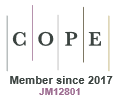The discovery of mechano-bactericidal surfaces
Denver P. Linklater A and Elena P. Ivanova B C *A
B
C

Dr Denver Linklater is a research fellow at the Ian Holmes Imaging Centre, The University of Melbourne. She is an expert in electron microscopy. Her research interests are in the design and synthesis of nanomaterials for novel anti-microbial technologies, stem cell culture and tissue re-generation. |

Elena Ivanova is a distinguished professor of RMIT University. Her research interests are in design and fabrication of biomimetic antimicrobial micro- and nano-structured surfaces, materials biointerfaces and immobilisation of biomolecules and microorganisms in micro- and nano-environments. |
Abstract
There is a long evolutionary history of bacteria adapting to surface colonisation and biofilm formation and a similar timeline of evolutionary advances for insects to develop resistance towards bacterial colonisation and biofilm formation. Many nanostructured surfaces are superhydrophobic, meaning they repel water and therefore other contaminants. A decade ago, we discovered that the superhydrophobic nanopillared surfaces of insect wings (e.g. cicadas, dragonflies and damselflies) kill bacteria through physical disintegration rather than repelling their attachment. It is now well documented that the biomimetic nanostructures, such as pillars and spikes, can physically damage bacterial cells, leading to cell lysis and death. Research involving replication of these nanostructures on biomaterials and implantable devices could eliminate the need for antibiotics to kill bacteria on such surfaces, offering a promising alternative for preventing infections.
Keywords: antibiotics, bactericidal surfaces, biofilm prevention, biomimetic nano-structured surfaces, cicada and dragonflies wings, physical rupturing of bacterial cells, post-antibiotic era, synthetic analogues of mechano-bactericidal surfaces.
 Dr Denver Linklater is a research fellow at the Ian Holmes Imaging Centre, The University of Melbourne. She is an expert in electron microscopy. Her research interests are in the design and synthesis of nanomaterials for novel anti-microbial technologies, stem cell culture and tissue re-generation. |
 Elena Ivanova is a distinguished professor of RMIT University. Her research interests are in design and fabrication of biomimetic antimicrobial micro- and nano-structured surfaces, materials biointerfaces and immobilisation of biomolecules and microorganisms in micro- and nano-environments. |
References
2 Roope LSJ et al. (2019) The challenge of antimicrobial resistance: what economics can contribute. Science 364, eaau4679.
| Crossref | Google Scholar | PubMed |
3 Habib MB et al. (2025) Biofilm-mediated infections; novel therapeutic approaches and harnessing artificial intelligence for early detection and treatment of biofilm-associated infections. Microb Pathog 203, 107497.
| Crossref | Google Scholar | PubMed |
4 Sriyutha Murthy P, Venkatesan R (2008) Industrial biofilms and their control. In Marine and Industrial Biofouling (Flemming HC, Murthy PS, Venkatesan R, Cooksey K, eds). Springer Series on Biofilms, vol. 4, pp. 65–101. Springer. 10.1007/978-3-540-69796-1_4
5 Galié S et al. (2018) Biofilms in the food industry: health aspects and control methods. Front Microbiol 9, 898.
| Crossref | Google Scholar | PubMed |
6 Hasan J et al. (2013) Antibacterial surfaces: the quest for a new generation of biomaterials. Trends Biotechnol 31, 295-304.
| Crossref | Google Scholar | PubMed |
7 Howell D, Behrends B (2009) Consequences of antifouling coatings – the chemist’s perspective. In Biofouling (Dürr S, Thomason JC, eds). pp. c1–c8. Wiley. 10.1002/9781444315462.ch16
8 Schumacher JF et al. (2008) Engineered nanoforce gradients for inhibition of settlement (attachment) of swimming algal spores. Langmuir 24, 4931-4937.
| Crossref | Google Scholar | PubMed |
9 Scardino AJ et al. (2008) Attachment point theory revisited: the fouling response to a microtextured matrix. Biofouling 24, 45-53.
| Crossref | Google Scholar | PubMed |
10 Bazaka K et al. (2011) Do bacteria differentiate between degrees of nanoscale surface roughness? Biotechnol J 6, 1103-1114.
| Crossref | Google Scholar | PubMed |
11 Mitik-Dineva N et al. (2009) Differences in colonisation of five marine bacteria on two types of glass surfaces. Biofouling 25, 621-631.
| Crossref | Google Scholar | PubMed |
12 Mitik-Dineva N et al. (2008) Impact of nano‐topography on bacterial attachment. Biotechnol J 3, 536-544.
| Crossref | Google Scholar | PubMed |
13 Ivanova EP et al. (2010) Impact of nanoscale roughness of titanium thin film surfaces on bacterial retention. Langmuir 26, 1973-1982.
| Crossref | Google Scholar | PubMed |
14 Ivanova EP et al. (2011) The influence of nanoscopically thin silver films on bacterial viability and attachment. Appl Microbiol Biotechnol 91, 1149-1157.
| Crossref | Google Scholar | PubMed |
15 Webb HK et al. (2013) Bacterial attachment on sub-nanometrically smooth titanium substrata. Biofouling 29, 163-170.
| Crossref | Google Scholar | PubMed |
16 Truong VK et al. (2010) The influence of nano-scale surface roughness on bacterial adhesion to ultrafine-grained titanium. Biomaterials 31, 3674-3683.
| Crossref | Google Scholar | PubMed |
17 Ivanova EP et al. (2011) Differential attraction and repulsion of Staphylococcus aureus and Pseudomonas aeruginosa on molecularly smooth titanium films. Sci Rep 1, 165.
| Crossref | Google Scholar | PubMed |
18 Webb HK et al. (2014) Wettability of natural superhydrophobic surfaces. Adv Colloid Interface Sci 210, 58-64.
| Crossref | Google Scholar | PubMed |
19 Hasan J et al. (2012) Spatial variations and temporal metastability of the self-cleaning and superhydrophobic properties of damselfly wings. Langmuir 28, 17404-17409.
| Crossref | Google Scholar | PubMed |
20 Ivanova EP et al. (2013) Molecular organization of the nanoscale surface structures of the dragonfly Hemianax papuensis wing epicuticle. PLoS ONE 8, e67893.
| Crossref | Google Scholar | PubMed |
21 Fadeeva E et al. (2011) Bacterial retention on superhydrophobic titanium surfaces fabricated by femtosecond laser ablation. Langmuir 27, 3012-3019.
| Crossref | Google Scholar | PubMed |
22 Truong VK et al. (2012) Air-directed attachment of coccoid bacteria to the surface of superhydrophobic lotus-like titanium. Biofouling 28, 539-550.
| Crossref | Google Scholar | PubMed |
23 Hasan J et al. (2013) Selective bactericidal activity of nanopatterned superhydrophobic cicada Psaltoda claripennis wing surfaces. Appl Microbiol Biotechnol 97, 9257-9262.
| Crossref | Google Scholar | PubMed |
24 Ivanova EP et al. (2012) Natural bactericidal surfaces: mechanical rupture of Pseudomonas aeruginosa cells by cicada wings. Small 8, 2489-2494.
| Crossref | Google Scholar | PubMed |
25 Owen CL et al. (2017) How the aridification of Australia structured the biogeography and influenced the diversification of a large lineage of Australian Cicadas. Syst Biol 66, syw078.
| Crossref | Google Scholar | PubMed |
26 Ivanova EP et al. (2013) Bactericidal activity of black silicon. Nat Commun 4, 2838.
| Crossref | Google Scholar | PubMed |


